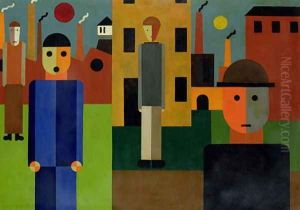Franz W. Seiwert Paintings
Franz Wilhelm Seiwert was a German painter, sculptor, and writer closely associated with the Constructivist and Dada movements, as well as with the Cologne Progressives during the Weimar Republic era. Born on March 9, 1894, in Cologne, Germany, Seiwert's early life was marked by an interest in art and politics, themes that would deeply influence his entire body of work. His artistic career was notably shaped by his socio-political beliefs, particularly his commitment to communism and his critique of bourgeois society, which he expressed through his art and writings. Seiwert's work is characterized by a stark, geometric style that reflects his interest in constructivism and his desire to make art that was accessible and relevant to the working class.
Seiwert's involvement with the Cologne Progressives, a group of artists who sought to address social issues through their work, was a critical aspect of his career. This collective aimed to create a new art form that would contribute to societal change, rejecting the traditional art establishment's focus on individualism and the commercialization of art. Seiwert, along with other members like Heinrich Hoerle and Anton Räderscheidt, experimented with various mediums and techniques, including painting, printmaking, and sculpture, to explore and communicate their revolutionary ideas.
Despite the innovative nature of his work, Seiwert faced significant challenges during his career, particularly with the rise of the Nazi regime. His art and his political activism made him a target for persecution, and many of his works were deemed degenerate by the Nazis. This not only led to censorship and the destruction of some of his pieces but also contributed to his relative obscurity in the years following his death on July 3, 1933, in Cologne, from complications related to surgery.
Throughout his short life, Franz W. Seiwert remained committed to his vision of a society where art played a crucial role in fostering social change. His legacy, though somewhat overshadowed by more prominent figures of his time, is preserved in various collections and museums that recognize his contribution to 20th-century art and politics. Seiwert's work continues to be studied and appreciated for its unique blend of political engagement and artistic innovation, offering insight into the tumultuous era of the Weimar Republic and the complex interplay between art and ideology.
